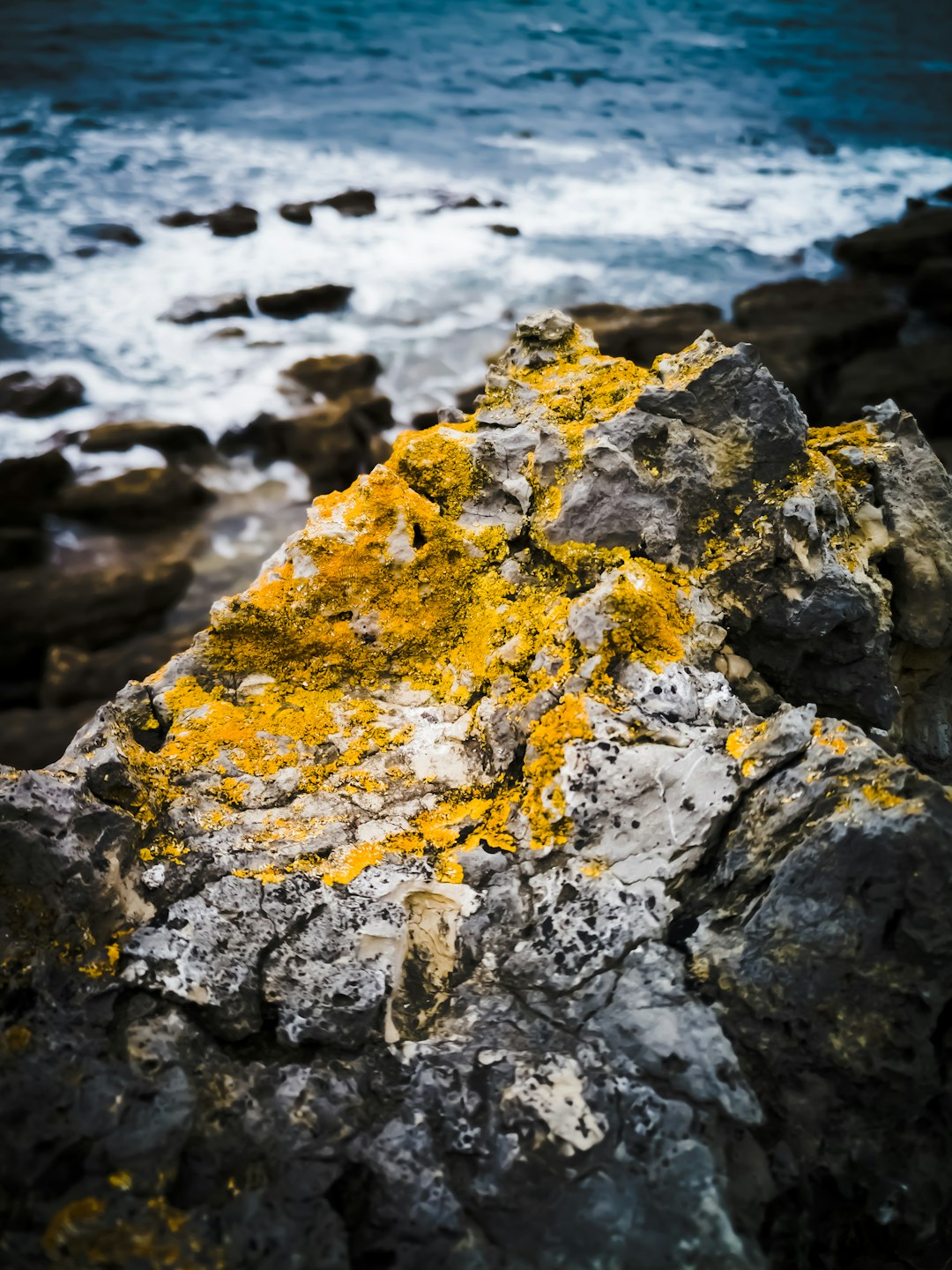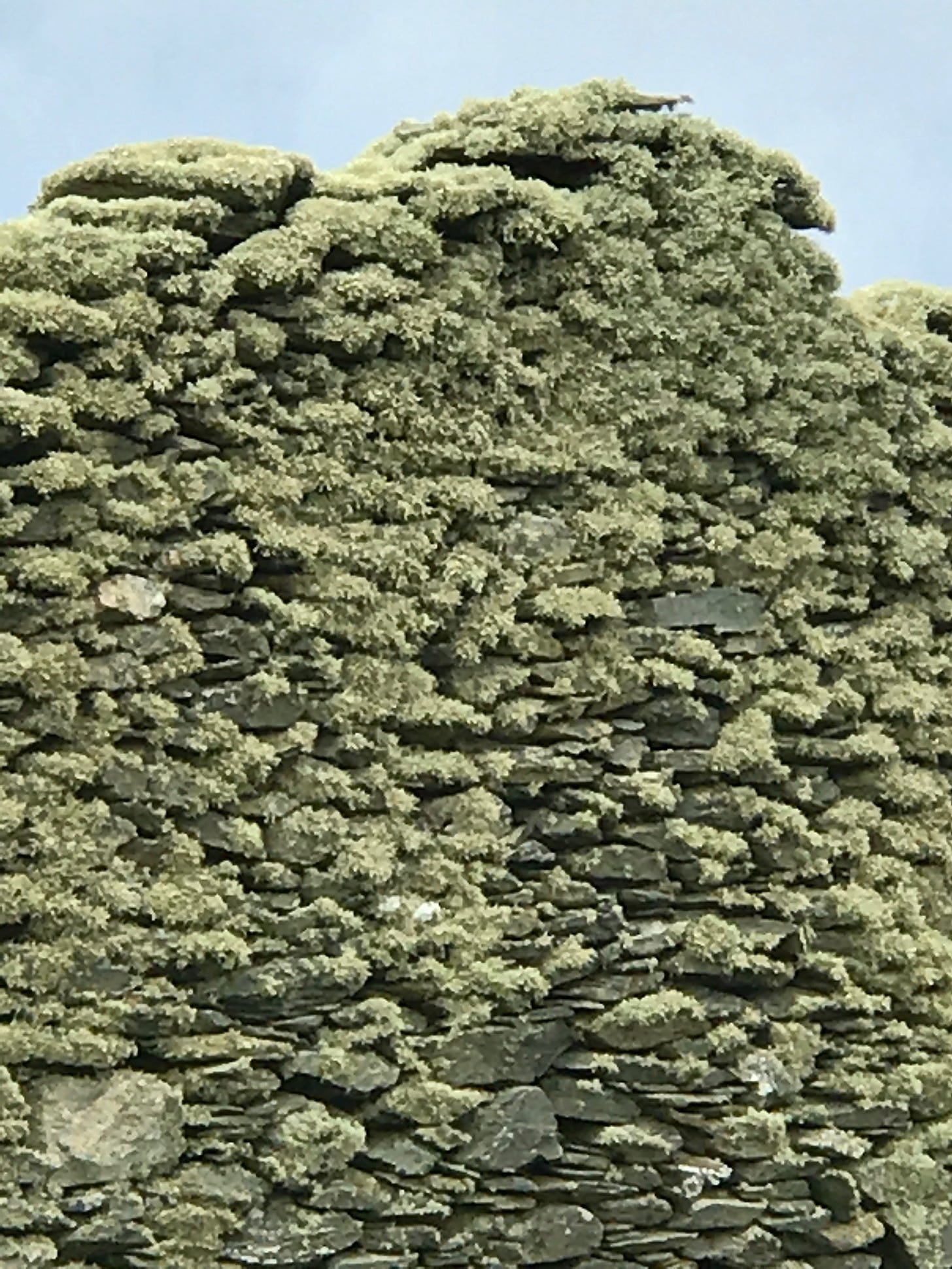“This is lichen,” Cillian the botanist told the Summer School ecology class on Inishbofin Island in Ireland. He pointed to a rock covered with the common substance, a soft rain dripping down its surface.
Lichens can be one of about 15,000 species, usually growing on rocks or trees, Cillian told us. But they can grow on almost any surface at almost any elevation in rainforests or temperate moist climates like Ireland. They can grow on roofs, gravestones and other lichens, even hang from branches, appearing to live on thin air.
We peered down at the lichen through our tiny hand lenses we wore around our necks. The stalks of the lichen looked like tree trunks, the tiny cups like meteoric craters.
Lichens are found world-wide. They have been eaten by humans and other animals, and have been a source of medicine and dyes. Before synthetic dyes, whole families scraped lichen off the rocks in Northern Europe to be used to dye wool. The dye was said to have preserved the wool from moths.
Large herds of migrating caribou often forage and eat sizeable amounts of lichen on their winter journeys. Able to photosynthesize at very low temperatures, lichens are well-adapted to northern climates as they can absorb vapor from the clouds and mist often found in areas of high elevation.
That morning we’d hiked along the trail through West Quarter, up past Cnoc Mor, and along the path toward the Stags, our elevation growing higher and higher. The landscape had become wilder, less populated, more and more open to the sounds of the birds circling overhead: the seagulls, oystercatchers and terns.
We’d left behind tales of Viking landings, the view of the harbor and pier, and the dark imposing castle-like barracks where Oliver Cromwell locked up Catholic priests during his bloody rule in the mid 1660s. The barracks symbolized Cromwell’s reign filled with colonialism, land confiscation, denial of religious freedom, rebellion and massacres.
Lichens are long-lived survivors, considered to be among the oldest living things. They made their home on the rocks of Inishbofin Island long before Cromwell, long before even the Iron Age promontory forts like Dún Gráinne, just opposite the Barracks, came into being. Lichens clung to the rocks, looking down on the Royal Oak Cove long before 1770 when a British ship was blown off course and wrecked, the debris splashing and banging up against the cliffs.
In 1867, scientists knew that lichens exist due to a symbiotic relationship between algae and fungi. But in 2016, new research found that there was a third partner, a yeast, often embedded in the lichen’s skin. Lichens have properties different from any one of their three components. Lichens look like plants, but they are not plants. Neither are they animals. They look like moss, but they are not moss. They do not have roots that absorb water and nutrients like plants, but like plants, they produce nutrients through photosynthesis, converting light into chemical energy to fuel their activities.
Lichens come in an array of sizes and shapes. They provide nutrients and camouflage for a variety of animals from grasshoppers to butterflies, to snails, slugs and beetles. Lichens also come in many colors, usually bright green or olive-gray. Special pigments, especially in dry habitats, can give lichens a whole new pallet with reds, oranges and yellows taking the stage. And lichen colors can change with moisture levels and the angle of the sun.
Lichens can grow close together, forming mats that help sequester carbon, regulate water tables, and prevent soil erosion. They are sensitive to air pollution. Just as frogs are good indicators of water quality, lichens are good indicators of air quality.
This wild, primitive, ever-fascinating, ever-changing organism can never really be defined. It is a keystone species in many ecosystems, having a disproportionately large influence on the natural environment in relationship to its size. Scientists are still researching its properties, still probing its mysteries.
“Lichen is so successful,” Cillian said. “But its success is based on symbiosis, or the co-operation between species. Its success is not based on the predator/prey “survival of the fittest” Darwinian concept. Species don’t always survive because they dominate. Here, they survive because they cooperate.”
Symbiosis. Yes, I remembered the word from my high school and college biology classes. Symbiosis: A relationship, for better or worse, between two different species who live together. The textbook page flashed in front of my eyes. Camouflage: Moths alighted on a tree to fool a bird, folding their wings to look like dead leaves. Flounder blending into the speckled sea floor to allude their predators.
I’d observed symbiosis in my own garden. My first encounters with tomato hornworms induced panic. The large, fat caterpillars ravaged my plants in just a few days. I grabbed the hornworms off the tomato leaves and immediately disposed of them, dropping them in a can of sudsy water. But the next time I encountered a hornworm on my tomatoes, I took a deep breath and observed them more acutely.
What were these tiny little white rice-like things hanging off the hormworms? Caterpillars don’t lay eggs. These caterpillars transform into sphinx moths, large fluttering insects I sometimes mistook for hummingbirds. I learned that the female braconid wasp lays her eggs through her ovipositor under the skin of the hornworm. The larvae hatch, feed on the hornworm’s viscera, then chew their way out through the host’s skin, killing off the hornworm. After that, when I saw a hornworm covered with wasp larvae, I left it alone.
Okay, I thought. But algae, fungi and sometimes yeast combining to form a new creature? Not just helping out another species, but becoming one. Was this what I was hearing from Cillian?
And all due to cooperation? This time, I reeled back to my geology classes, the garfish, a living fossil, crawling out of the sea with the ability to breathe air. Darwin again. The biggest and the strongest survive. A species selects for the one who can fight off the competition.
We began hiking back down toward the harbor and the Cromwellian Barracks. Yes, certainly, the Darwinian principle exists.
But we can also acknowledge the cooperative model in nature, how one species may help another, and how a couple of species may even combine to develop an even better idea.
In their book The Survival of the Friendliest, cognitive and research scientists Brian Hare and Vanessa Wood shed light on the survival of Homo sapiens. Rather than brute strength or aggression, Homo sapiens thrived due to their friendliness and ability to cooperate and communicate with others. Yet even with supportive alliances, Homo sapiens remained threatened by outsiders. And so, humans can be both the most cooperative and the cruelest of species.
We hiked by mortarless stone walls, each rock wedged tightly against another, covered with lichen. Once I was attuned to the organism, I saw it everywhere.
Maybe, I thought, we could all adjust our lenses and work toward focusing on powerful, peaceful partnerships, breaking through old paradigms. Maybe, just maybe, in the future, we could feel secure in the stable communities we created. Then we could truly evolve, dropping our hostilities.
Yes, certainly, the cooperative principle also exists.
Below, in the harbor, we watched men in currachs row out into the sea, leaving the Barracks behind.
For the people from this tiny island spread, like lichen, all over the world.
Find out more about Mary Swander on her website:
The paid subscriptions to this newsletter are donations to AgArts, a non-profit that imagines and promotes healthy food systems through the arts. Make a donation of any amount to AgArts here:
Please read and support my colleagues at the Iowa Writers Collaborative. Check out our Sunday Round-Up for a sample of our work:








Great article Mary. Love how you tie detailed botanical and geological information into a narrative relating back to symbiosis in your garden, then back out to global implications.
This is the second time in a couple of weeks that I have heard homo sapiens might have survived--and thrived--because of cooperation and communication. Thank you for this thoughtful, thought-provoking post, Mary. I am liking the lichens (sorry couldn't help it!) Ancient beings with something new and old to teach us. Inspiring.